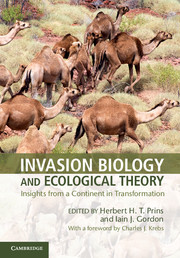Book contents
- Frontmatter
- Contents
- List of Contributors
- Foreword
- 1 Testing hypotheses about biological invasions and Charles Darwin’s two-creators rumination
- Part I Ancient invaders
- 2 Australia’s Acacia: unrecognised convergent evolution
- 3 The mixed success of Mimosoideae clades invading into Australia
- 4 Perspectives from parrots on biological invasions
- 5 Invasion ecology of honeyeaters
- 6 The invasion of terrestrial fauna into marine habitat: birds in mangroves
- 7 The biological invasion of Sirenia into Australasia
- 8 Flying foxes and drifting continents
- 9 Invasion ecology of Australasian marsupials
- 10 Murine rodents: late but highly successful invaders
- 11 Drift of a continent: broken connections
- 12 The development of a climate: an arid continent with wet fringes
- Part II Modern invaders
- Index
- References
11 - Drift of a continent: broken connections
from Part I - Ancient invaders
Published online by Cambridge University Press: 05 February 2014
- Frontmatter
- Contents
- List of Contributors
- Foreword
- 1 Testing hypotheses about biological invasions and Charles Darwin’s two-creators rumination
- Part I Ancient invaders
- 2 Australia’s Acacia: unrecognised convergent evolution
- 3 The mixed success of Mimosoideae clades invading into Australia
- 4 Perspectives from parrots on biological invasions
- 5 Invasion ecology of honeyeaters
- 6 The invasion of terrestrial fauna into marine habitat: birds in mangroves
- 7 The biological invasion of Sirenia into Australasia
- 8 Flying foxes and drifting continents
- 9 Invasion ecology of Australasian marsupials
- 10 Murine rodents: late but highly successful invaders
- 11 Drift of a continent: broken connections
- 12 The development of a climate: an arid continent with wet fringes
- Part II Modern invaders
- Index
- References
Summary
Introduction
We live on a continually shifting planet as the continents on which we have built our lives drift across the Earth’s surface, a process which has changed the configuration of the continents throughout Earth’s history and will continue to do so. A world map 250 Ma from now will reveal a very different arrangement of continents in the northern hemisphere than that observed today. Earth science studies have revealed the processes associated with continental movement known as plate tectonics; we have learnt that the Earth is made up of lithospheric plates carrying the continents and oceans, which driven by mantle processes are in continuous motion (Skinner and Porter 1987).
A map of the Earth’s plates (Figure 11.1) reveals the relative movement of each plate and their interactions along their boundaries such as subduction around the Pacific Ring of Fire, spreading along the Mid-Atlantic Ridge and transform faulting at the San Andreas Fault (Skinner and Porter 1987; Kearey and Vine 1996). Our world has been, and will continue to be, shaped by the movement of these plates (Skinner and Porter 1987).
- Type
- Chapter
- Information
- Invasion Biology and Ecological TheoryInsights from a Continent in Transformation, pp. 241 - 255Publisher: Cambridge University PressPrint publication year: 2014
References
- 1
- Cited by

